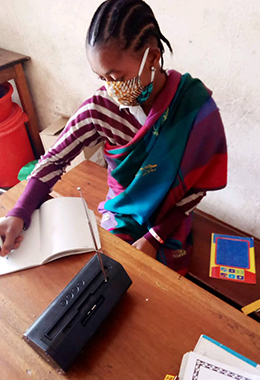Interactive Audio Instruction Makes a Comeback

According to the United Nations, the coronavirus pandemic (COVID-19) “has created the largest disruption of education in history, affecting nearly 1.6 billion learners.” UNICEF reports that “at least a third of the world’s schoolchildren [have been] unable to access remote learning” during the pandemic. Even at the start of 2021, the learning of more than 136 million children continues to be affected, with 13 countries experiencing country-wide school closures, and many more seeing partial closures in response to changing infection rates.
These interruptions in formal education have had, and will continue to have, a devastating impact on young learners in affected communities. Since April, EDC has worked with UNICEF, UNESCO, the World Bank, the Inter-American Development Bank, and multiple ministries of education to mitigate this impact by expanding access to distance learning through interactive audio instruction (IAI).
IAI is a low-cost, high-impact educational intervention that uses radio and audio devices to keep children around the world engaged in learning, whether inside or outside of the classroom. Successful IAI interventions pay attention to existing local resources and the availability of access to information and communication channels, such as radio, mobile audio, computers, cassette players, or other popular technologies.
Equally important, IAI works with education officials and community leaders to develop scripted content aligned with each country’s national curricula and locally adapted so listeners can understand concepts within a familiar context. EDC’s IAI content covers multiple subjects, including literacy, numeracy, science, and life skills, and is available in multiple languages.
“Having an extensive archive of pre-existing audio programming has allowed us to respond quickly to education needs arising from COVID-19 school closures,” says Rachel Christina, EDC director of International Basic Education. “We have been able to work with ministries of education to quickly update, adapt, and push out audio-based learning to children and youth at home during lockdown.”
IAI_2.jpg

In the Democratic Republic of the Congo (DRC), for example, youth volunteers supported learners in a non-formal program for out-of-school youth prepare for the primary equivalency exams. Volunteers helped learners use EDC’s previously developed IAI content for grades 5 and 6, distributed print resources to complement audio instruction, monitored homework assignments, and coached learners. In Mali, a set of radio-based parent orientation sketches were developed to guide parents through national broadcasts of pre-existing EDC IAI programming and to support learning goals for their children. And in Zambia and Honduras, existing literacy materials were adapted for audio delivery in short story sequences, and a series of tips for home learning were provided to caregivers.
“We’ve worked to provide resources that not only help to facilitate home access to educational audio but also to reinforce what and how children are learning,” says Christina. “In the past, this has meant mobile phone apps for educators to create peer networks as well as other digital tools to support teachers in classrooms. In the COVID-19 context, we are pivoting to strengthen parental guidance and community support so caregivers can better facilitate and engage with children’s learning outside of a classroom setting.”
Research has shown that IAI can improve the quality of teaching and learning in a range of contexts across subject matter, age, gender, and location. So while the effects of COVID-19 on education outcomes will be profound, Christina believes that this moment has created a renewed opportunity to address access and learning challenges that many ministries have grappled with for years.
“IAI is not a panacea,” Christina says. “But our experience shows that it can promote educational resilience and strengthen the way education systems everywhere expand learning beyond the classroom. It can also develop instructional supports that engage teachers and the wider community and, ultimately, reach more vulnerable and out-of-school children—regardless of a pandemic, a natural disaster, or an unforeseen crisis.”